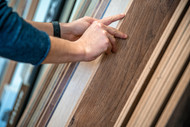Expert Tips for Choosing the Perfect Timber for Your Woodworking Project
29th Feb 2024
Choosing the perfect timber for your woodworking project is a crucial decision that can significantly impact the outcome of your work. Wood, with its natural beauty and versatility, offers a wide range of options for any project, from furniture making to structural applications.
In this guide, the expert team from Canterbury Timber will walk you through the process of selecting the ideal timber, considering factors such as wood species, grading and quality standards, moisture content, and more, to ensure your woodworking project is both beautiful and durable.
Understanding Wood Species
The species of wood you choose is the first critical decision in your project. Each species has unique characteristics, including colour, grain pattern, hardness, and workability.
Hardwoods like oak, maple, and walnut are renowned for their durability and are commonly used in furniture and cabinetry. Softwoods, such as pine, cedar, and spruce, are easier to work with and are often used in construction and decorative applications. Consider the intended use of your project and the desired aesthetic when selecting a wood species.
Grading and Quality Standards
Wood is graded based on its appearance and structural qualities. The grading system varies between hardwoods and softwoods but generally assesses factors like the number and size of knots, the presence of defects, and the overall uniformity of the board.
Higher grades indicate a higher quality of wood, which is essential for projects requiring a smooth, uniform appearance. Understanding these standards can help you make informed decisions and ensure you're purchasing the right quality timber for your project.
Moisture Content and Stability
The moisture content of wood affects its stability and suitability for certain projects. Wood expands and contracts with changes in humidity, which can lead to warping or cracking. It's essential to choose timber with a moisture content appropriate for the environment where the finished project will reside.
For indoor projects, kiln-dried wood with a lower moisture content is ideal to minimise movement. For outdoor projects, consider wood that has been treated or is naturally resistant to moisture and decay.
Considerations for Specific Projects
Different projects require different types of wood, based on factors like strength, durability, and appearance. For structural projects, such as building frames or outdoor decks, choose strong and durable timber that can withstand the elements, like treated pine or cedar.
For decorative projects, such as carving or furniture making, select wood with a pleasing grain pattern and colour, like walnut or cherry. Always consider the specific requirements of your project when choosing your timber.
Sustainability and Environmental Impact
The sustainability of timber is an increasingly important consideration. Opt for wood sourced from responsibly managed forests, certified by recognised organisations. Reclaimed wood is also an eco-friendly option, providing a unique aesthetic while reducing the demand for new timber. Choosing sustainably sourced wood ensures your project has a lower environmental impact and supports responsible forestry practices.
Expert Tips and Best Practices
- Research Thoroughly: Spend time researching the properties and uses of different wood species to find the best match for your project.
- Inspect Before Buying: Always inspect timber for defects like knots, splits, and warping before purchasing.
- Measure Twice, Cut Once: Ensure you’ve thoroughly planned and measured before cutting your timber to size. If in doubt, Canterbury Timber offers a cutting and milling service to take the stress out of the process.
- Acclimate Your Wood: Allow your timber to acclimate to your workshop's environment before starting your project to reduce the risk of movement or distortion.
- Finish Properly: Applying the right finish will protect the wood and enhance its natural beauty. Consider the use of your project and choose a finish that provides the appropriate level of protection.
Which Wood You Rather?
Selecting the right timber is essential for the success of any woodworking project. By understanding the characteristics of different wood species, considering the project's specific needs, and opting for sustainable sources, you can ensure your finished project is not only beautiful but also built to last.
For more advice and to get started on your project, contact us today.
FAQs
What types of timber are best for different woodworking projects?
The best type of timber varies by project. For structural uses, opt for strong, durable woods like oak or treated pine. For decorative projects, choose woods with appealing aesthetics, like walnut or cherry.
How can I determine the quality of timber materials before purchasing?
Examine the wood for defects such as knots, cracks, and warping. Familiarise yourself with grading standards for the species you're buying to ensure it meets your project's requirements.
What are the differences between hardwood and softwood timber?
Hardwoods, derived from deciduous trees, are generally denser, more durable, and have a finer grain, making them ideal for furniture and cabinetry. Softwoods come from coniferous trees and are lighter, making them suitable for construction and some types of decorative work.
What are the best practices for preserving and treating timber to prolong its lifespan?
Proper finishing is key. Use sealants, varnishes, or oils suitable for your project's specific needs. For outdoor projects, consider using pressure-treated wood or apply protective coatings to guard against moisture and decay.

